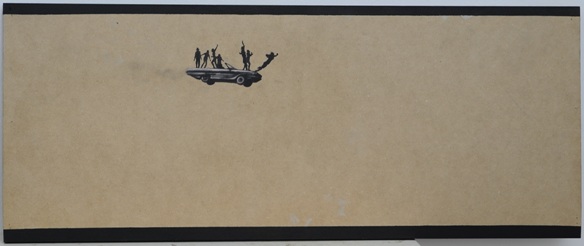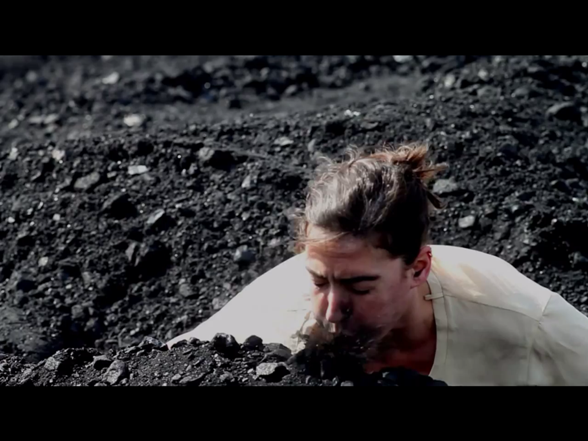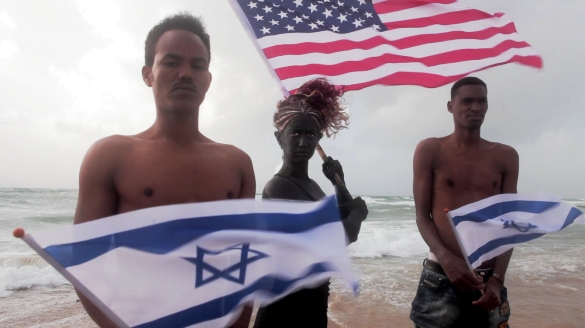I have a friend who refuses to have anything at all to do with the Israeli art scene. Her argument is that it is inherently narcissistic: too steeped with the meta-issue of Israel’s place in the international art arena to have anything genuinely interesting to say about local concerns. I take her point, but I don’t entirely agree. What is creativity if not the expression of narcissism: the conviction that one has something important to say, and in a way that no-one else can manage, anyway? The real issue, I think, is how well the impulse is mediated, how far it allows for reflexive over reactive thinking.

Oddly enough, video is the dominant medium at Bezalel’s annual MFA Graduate Show, running from today until 11th July. Maybe this shouldn’t surprise. Anyone can play cameraman nowadays, thanks to advances in technology. There are quite a few installations based around found objects too. Some abstractions on canvas. Not much representational – in the traditional sense – artwork. The emphasis is, I think, very much on the personal experience. It’s a part of what my friend refers to disparagingly as narcissism, but I think the personal embodies much potential. It’s all a matter of self-awareness.
The exhibition is presented very much along democratic principles, the upstairs gallery presenting each of the 18 graduating students in individual spaces, the cavernous network of rooms on the ground floor given over to a joint exhibit of sorts. I say “of sorts” because it feels more like an extension of the individual displays, the thrust of the over-arching narrative eluding me. There is, though, the commitment to use the space as they find it, which creates interesting juxtapositions of form and shape.

Take Mirit Weinstock’s untitled sound and video installation, for instance. I wonder what bearing her alternative existence – as a jeweller – might have had some bearing on her work. A looped recording is commentary from a 200m race featuring Usain Bolt, gradually speeding up until it becomes unintelligible. It’s only after recovering from the disorientating rush of sound that one becomes aware of a window looking out onto two screens. We see a woman blowing, furiously, energetically, at a huge mound of coal. In moments of repose she seems surprisingly composed, not at all deterred by the Sisyphean task confronting her. Perhaps, she’s hoping to speed up time, turn the coal into diamonds. I don’t know. But it does have a beguiling effect.

Kookhee Lee is a Korean transplant to Israel, but 10 years still describes life in her adopted home as a “fight”. Incidentally, she has a video too, Yoman, that tries to encapsulate the experience of apartness: she’s in her apartment, playing Mortal Combat on her game console. She wins some, but ultimately loses. It reminds me of the British statesman who once remarked wryly that all political careers end up in failure. Israel isn’t quite so harsh to outsiders, but it does run close sometimes. She isn’t quite as pessimistic about her place in the country as the video might suggest though, which I think is a good thing. Israel needs people who have the privilege of being on the inside without being a part of the inside, if you catch my drift.
Her photographs piqued my interest more, perhaps because they are rather oblique but yet not disinterested. There’s one, ostensibly of a horse. The creature is so effectively camouflaged in the foreground that the viewer’s eyes are drawn to the background, and specifically to the Security Wall running across the landscape. It’s odd, because the wall is a political juxtaposition, but it almost – almost – blends naturally with the landscape. Almost as if it wasn’t intended to be seen.

I often struggle with the phrase “political correctness” in Hebrew. Not the words – although they’re hard enough to translate – but the concept. It doesn’t really exist in these parts. Tamar Hirschfeld’s multimedia installation, Schwartze Unveiled, works round this paucity of vocabulary by simply ignoring it. Blackface has been an absolute no-no in the western world for some time. Hirschfeld embraces it with a gleeful abandon, blacking up and placing herself in a range of bewildering, sometimes deeply unsettling tableaux. She explains that she consciously embraced the provocative vulgarity of her creation (and you don’t get much more provocative than playing a Chopin etude in blackface, then pausing to solemnly eat a banana) because it reflects the level of discourse about race and ethnicity in Israel today. Schwartze Unveiled looks outwards too: the underpinning conceit, I think, is the constant, sometimes limiting, negotiation of identity that Israeli Jews often find themselves caught up in both inside and outside the country (Schwartze, the derogatory Yiddish word for negroes, was similarly used to described the Jews of Germany once upon a time.) It’s unsettling, will probably upset people, and completely subjective. In short, it’s narcissistic. But in the best possible way. I’m going to recommend the show to my friend. I hope she has enough patience to grasp the underlying intent.
The MFA Graduate Show of the Bezalel Academy of Arts and Design runs at Salame 60, Tel Aviv from 1-11 July 2013.
Participating artists: Diana Ashurov, Mirna Bamieh, Adi Brande, Hili Greenfield, Kookhee Lee, Tamar Hirschfeld, Mirit Weinstock, Mark Yashaev, Shavit Yaron, Roy Yariv, Eran Nave, Porat Salomon, Hila Karbeknikov-Pax, Elad Roasen, Pearl Schneider, Amir Sheft, Avinoam Sternheim, David Schocken.






Comments are closed.